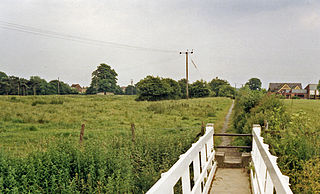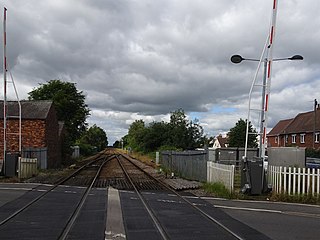Related Research Articles

A railcar is a self-propelled railway vehicle designed to transport passengers. The term "railcar" is usually used in reference to a train consisting of a single coach, with a driver's cab at one or both ends. Some railway companies, such as the Great Western, termed such vehicles "railmotors".

A switcher, shunter, yard pilot, switch engine, yard goat, or shifter is a small railroad locomotive used for manoeuvring railroad cars inside a rail yard in a process known as switching (US) or shunting (UK). Switchers are not intended for moving trains over long distances but rather for assembling trains in order for another locomotive to take over. They do this in classification yards. Switchers may also make short transfer runs and even be the only motive power on branch lines and switching and terminal railroads. The term can also be used to describe the workers operating these engines or engaged in directing shunting operations. Switching locomotives may be purpose-built engines, but may also be downgraded main-line engines, or simply main-line engines assigned to switching. Switchers can also be used on short excursion train rides.

The Birmingham Railway Carriage and Wagon Company (BRC&W) was a railway locomotive and carriage builder, founded in Birmingham, England and, for most of its existence, located at nearby Smethwick, with the factory divided by the boundary between the two places. The company was established in 1854.
A number of different numbering and classification schemes were used for locomotives and multiple units operated by British Railways (BR), and this page explains the principal systems. This section also covers the post-privatisation period, as the broad numbering and classification arrangements have not altered since the break-up of BR.
The London and North Eastern Railway (LNER) produced several classes of locomotive, mostly to the designs of Nigel Gresley, characterised by a three-cylinder layout with a parallel boiler and round-topped firebox. It produced the most famous locomotive of its day, 4468 'Mallard', the holder of the world steam locomotive speed record. It also built the world-famous 4472 'Flying Scotsman'. However, its locomotive inheritance was much greater than just the 'A4 Class', it also produced highly successful mixed-traffic and freight designs.
The London, Midland and Scottish Railway (LMS) pioneered the use of diesel shunting locomotives in Great Britain. The variety of experimental and production diesel shunters produced by the LMS is summarised below.

The North Eastern Railway Class T2, classified as Class Q6 by the LNER, is a class of 0-8-0 steam locomotive designed for heavy freight, especially for hauling long coal trains to various collieries in the North Eastern region of the UK, with a maximum speed of 40 miles per hour. 120 were built at Darlington Works and Armstrong Whitworth between 1913 and 1921 to the design of Vincent Raven, based on the NER Class T and T1. The batch of fifty built by Armstrong Whitworth from 1919 were A-W's first locomotives to be built, after the conversion of their Scotswood works from ordnance to peacetime production.

The Great Central Railway (GCR) Class 9F was a class of 0-6-2T steam locomotive built between 1891 and 1901. From 1923 the locomotives were redesignated Class N5.

The LNER electric units were electric multiple units that ran on the Tyneside Electrics, a suburban system based on the English city of Newcastle upon Tyne. In 1937 the London and North Eastern Railway (LNER) received articulated twin passenger electric units to replace the NER electric units that had been built in 1904–15 by the North Eastern Railway. The order including some single-unit motor parcel vans and motor luggage vans. In the 1960s declining passenger numbers and the high cost of renewing life-expired electric substation equipment across the system led to the replacement of the electric multiple units with diesel multiple units and the units were all withdrawn in 1967.
A number of different numbering and classification schemes were used for the locomotives owned by the London and North Eastern Railway (LNER) and its constituent companies. This page explains the principal systems that were used. The following abbreviations for the constituent companies are used on this page:

Neville Hill is a railway train maintenance depot in Osmondthorpe, Leeds, England on the Leeds to Selby Line. The depot is situated 2 miles 14 chains (3.5 km) to the east of Leeds railway station on the north side of the line.
The Drewry Car Co was a railway locomotive and railcar manufacturer and sales organisation from 1906 to 1984. At the start and the end of its life it built its own products, for the rest of the time it sold vehicles manufactured by sub-contractors. It was separate from the lorry-builder, Shelvoke & Drewry, but it is believed that James Sidney Drewry was involved with both companies.

The Class EF1 was a class of electrically powered locomotives built by the North Eastern Railway from 1914. They were built to haul coal trains from the mines at Shildon to the docks at Middlesbrough. In common with other LNER electric locomotives, no classification was given to these locomotives until 4 October 1945, when nos. 3-12 were all classified EB1 although only no. 11 was actually modified for banking. It was expected that all the locomotives would be similarly modified, but this did not happen, and the remaining locos were classified as EF1.

The 1903 Petrol Electric Autocars were built by the North Eastern Railway in 1903 at their carriage works in York. These were powered by petrol engines which generated electricity for two traction motors which were mounted on the bogie underneath. This means of powering a railway vehicle was pioneering and would eventually be developed into the diesel-electric technology that powered and powers many locomotives worldwide. The railcars were numbered 3170 and 3171 and were 53.5 feet (16.3 m) long and weighed around 35 long tons (36 t). The engine was mounted in an engine compartment 13.25 feet (4.04 m) long. The rest of the vehicles' length was taken up by a vestibule, driving compartment and a 52-seat passenger compartment.

The Cawood, Wistow and Selby Light Railway (CW&SLR) was a short light railway in a rural part of Yorkshire, England. The company was sometimes referred to as the Cawood, Wistow and Selby Railway.

Diesel multiple units and railcars are trains, usually with passenger accommodation, that do not require a locomotive. Railcars can be single cars, while in multiple units cars are marshalled together with a driving position either end. As of December 2010, 23 percent of the rail passenger cars used on Network Rail are part of a diesel multiple unit.
Petrol–electric transmission or gasoline–electric transmission or gas–electric transmission is a transmission system for vehicles powered by petrol engines. Petrol–electric transmission was used for a variety of applications in road, rail, and marine transport, in the early 20th century. After World War I, it was largely superseded by diesel-electric transmission, a similar transmission system used for diesel engines; but petrol-electric has become popular again in modern hybrid electric vehicles.

Cawood was the northern terminus of the short Cawood, Wistow and Selby Light Railway (CW&SLR), in rural North Yorkshire, England. The line was connected to the North Eastern Railway (NER) at its southern end.
Wistow was the sole intermediate station of the short Cawood, Wistow and Selby Light Railway (CW&SLR), in rural North Yorkshire, England. The line was connected to the North Eastern Railway (NER) at its southern end.

Selby was the initial, temporary southern terminus of the short Cawood, Wistow and Selby Light Railway (CW&SLR) in North Yorkshire, England. The line was connected to the North Eastern Railway (NER) nearby. The station is sometimes referred to as "Brayton Gates" or plain "Selby", though it was around a mile from the much larger Selby station.
References
- ↑ "LNER Internal Combustion Locomotives". LNER Encyclopedia.
- ↑ "The Armstrong-Whitworth 1-Co-1 Diesel-Electric Locomotive". LNER Encyclopedia.
- ↑ "The Armstrong-Whitworth Diesel-Electric Railcars". LNER Encyclopedia.
- ↑ Allen (1959), p. 35.
- ↑ "The NER Petrol Inspection Cars". LNER Encyclopedia.
- ↑ "The NER Petrol-Electric Autocars". LNER Encyclopedia.
- ↑ "The NER Petrol Rail Motor Bus". LNER Encyclopedia.
- ↑ "The NER Petrol Autocar". LNER Encyclopedia.
- ↑ "The GCR Petrol-Electric Railcar". LNER Encyclopedia.
- Allen, G. Freeman (1959). British Railways today and tomorrow. Ian Allan.